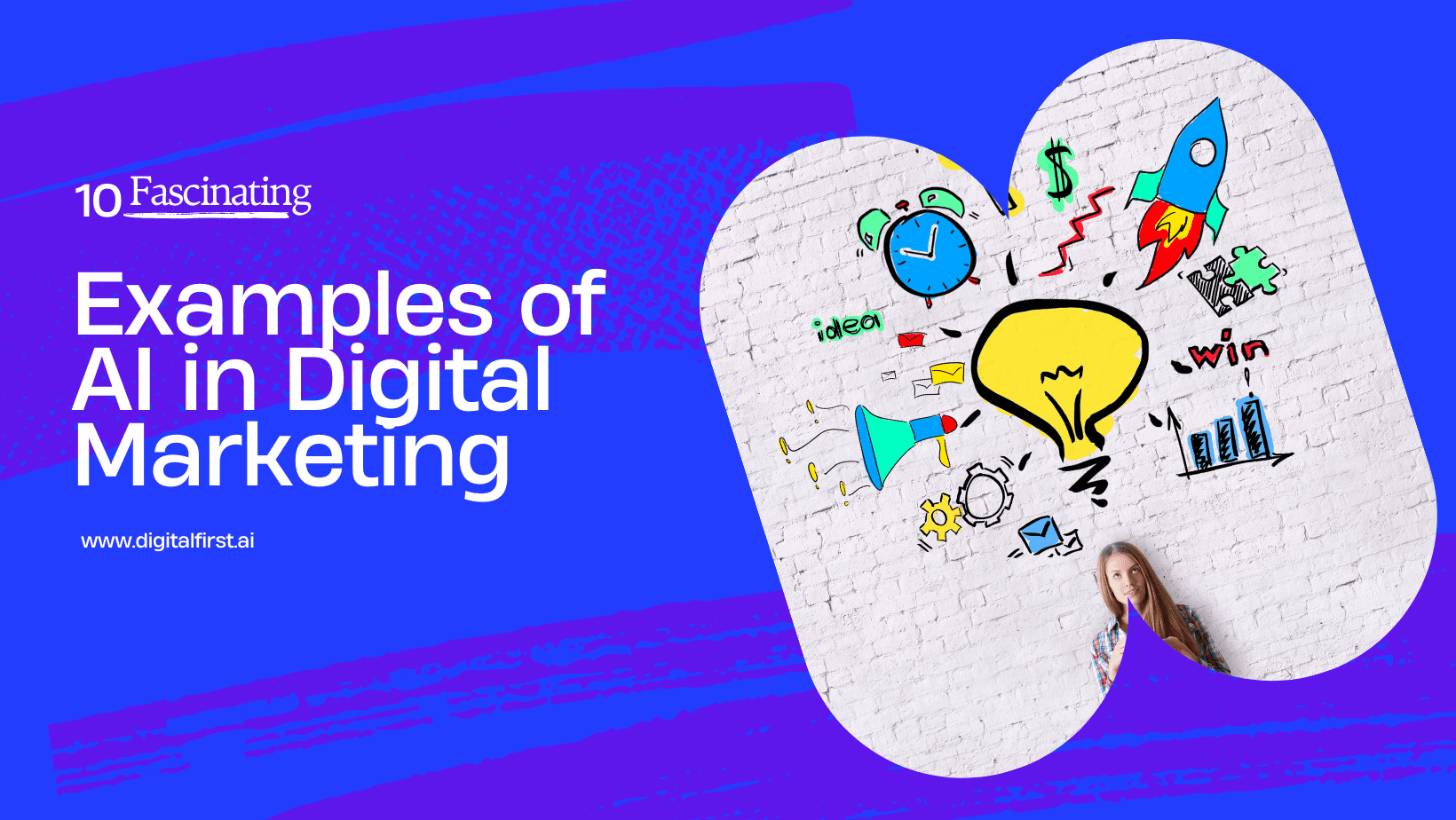Customer Journey Mapping 101: Everything You Need to Know
Master the art of customer journey map creation with our comprehensive guide, featuring step-by-step instructions and expert tips.
Sonu kalwar
Share:
Ever wondered why people pick your competitors over you?
It's not just about being popular or having fancy ads.
The real reason is the journey customers take before they decide to buy.
The path from where they start to your competitor's business isn't simple.
To understand why this journey matters, consider this: 72% of happy customers tell at least 6 friends about it. But if they're not happy, 13% will complain to 15 people or more.
Yes, it might not seem fair, but it's the truth.
This shows that a positive journey can spread good words, but a bad experience can lead to more negative reviews.
So, let's explore everything a customer journey map can do for your company – from understanding your customers better to improving your marketing strategy.
Try Digital First AI's Plug & Play AI-Powered Marketing Workflows Builder

No credit card needed. Instant access. Try now for free.
Understanding Customer Journey Map
Before we discuss what customer journey mapping is, let’s first understand what it isn't.
A "Customer Journey Map" is like a picture that shows all the steps customers take when they buy something. It helps businesses understand how customers feel and what they do at each step.
On the other hand, a "Customer Journey" is just the path customers take when they're deciding to buy. It's like the road they travel.
So, the map helps businesses understand this road and make it better for customers!
Now, let's return to the main topic of this post, the customer journey map.
A Customer Journey Map is a visual representation of the various stages a customer goes through when interacting with your business, from initial discovery to post-purchase engagement.
The stages of a customer journey map
Awareness: Also, know as Top of the Funnel (ToFu). This is the stage where customers become aware of a product, service, or brand. They may come across advertisements, social media posts, or recommendations from friends.
Consideration: In this stage, customers actively research and evaluate different options. They compare features, read reviews, and gather information to make an informed decision.
Decision: Also, know as Middle of the Funnel. This is the stage where customers make a purchase or commit to a specific product or service. They may complete a transaction online or in-store.
Retention: Also, know as Bottom of the Funnel. After the purchase, businesses aim to retain customers and ensure their satisfaction. This stage focuses on providing excellent customer service, addressing any issues, and building loyalty.
Loyalty: In this stage, businesses aim to turn customers into loyal advocates. They focus on building long-term relationships, encouraging repeat purchases, and generating positive word-of-mouth.
5 Key Components of a Customer Journey Map
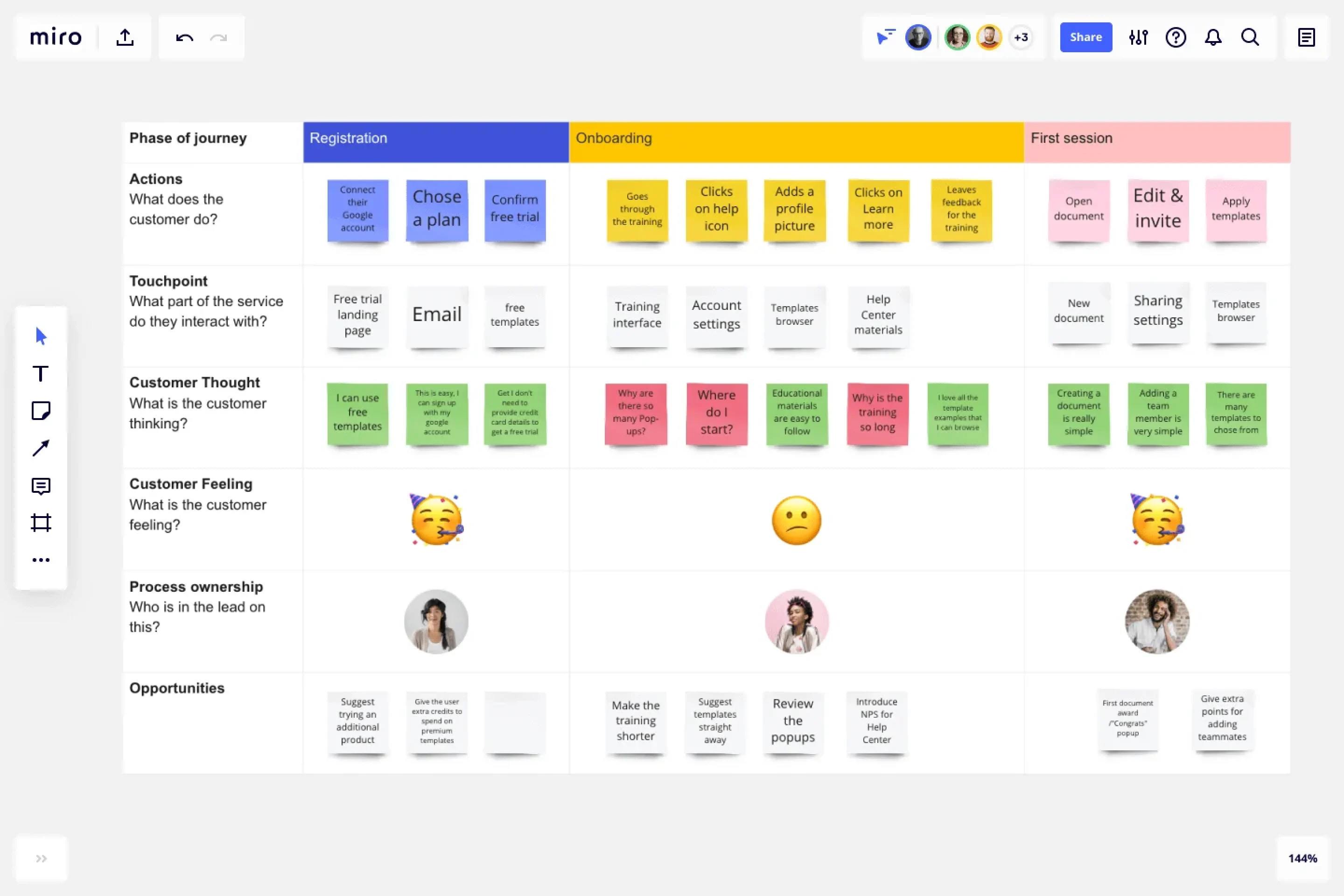
To create a customer journey map, you need to understand these five key components.
Each one is equally important in creating an enriching buying experience for your customers—and growing your business as a result.
Buyer Persona: This is like creating a character in a story. You figure out who your typical customer is, what they like, and what problems they have.
Map Touchpoints: Imagine all the times a customer interacts with your business, like visiting your website or talking to your team. These are touchpoints, and they're super important.
Analyze Customer Behavior: This is like studying how your customer acts. Do they look at a lot of products before buying? Do they ask questions? Understanding this helps you know what they want.
Visualize the Journey: This is when you draw out the whole story on a map. It shows the steps your customer takes from the start to the end, and what they feel along the way.
Customer Emotions: Ever notice how you feel different at different parts of a story? Well, it's the same for customers. Figuring out how they feel at each step helps you make them happier.
Why Create a Customer Journey Map
Creating a customer journey map is a crucial practice in modern business and marketing strategies because it helps you understand and empathize with your customers.
Now that competition is fierce, consumers have a lot of choices—which means businesses must work harder to win (and keep) their business.
It also helps companies:
Clear Objectives for Creating a Map
Businesses create customer journey maps when they want to understand the experience of their customers.
The map outlines the different stages that a person goes through during interactions with one or more products and services—and it also shows how much time is spent on each stage s that they help businesses reach those goals:
Understanding Customer Experience: The primary aim is to gain a deep understanding of what customers go through when they engage with your business. This includes their thoughts, emotions, and actions at each step.
Identifying Pain Points: By mapping out the journey, you can spot any pain points or difficulties customers might face. This insight helps in addressing these issues and making the experience smoother.
Enhancing Customer Satisfaction: When you know exactly where customers might be having trouble or where they're happiest, you can make improvements that enhance their overall satisfaction.
Benefits of Mapping the Customer Journey
Creating a customer journey map offers several benefits that contribute to a better business-customer relationship and ultimately, improved business outcomes.
Here are some of the key benefits:
Customer-Centric Approach: Mapping the journey puts the focus on the customer, helping you see things from their perspective. This customer-centric approach leads to better decisions tailored to their needs.
Effective Communication: Teams within a company can better understand and communicate about the customer's experience. This leads to more coordinated efforts to improve various touchpoints.
Spotting Opportunities: The map can reveal areas where you can introduce new features or services that customers would value, thus driving innovation.
Higher Customer Loyalty: Addressing pain points and providing a smoother experience fosters loyalty. Happy customers are more likely to stay and recommend your business to others.
Informed Decision-Making: Data-driven decisions become easier as you have a visual representation of how customers behave and what they prefer.
How It Helps Improve the Customer Experience
A customer journey map can lead to a number of improvements in the way your company interacts with its customers, including:
Personalization: With a clear map in hand, you can tailor interactions to individual preferences and needs, making customers feel valued and understood.
Consistency: A mapped-out journey helps maintain consistency across various touchpoints, ensuring that customers receive a unified and coherent experience.
Problem Resolution: By identifying pain points, you can proactively address issues and offer solutions, preventing customer frustration.
Efficiency: Understanding the journey helps in streamlining processes and removing unnecessary steps, which saves customers' time and effort.
Emotionally Resonant Experiences: Knowing when customers might feel delighted or disappointed allows you to create emotionally resonant experiences that leave a lasting positive impression.
Creating a Customer Journey Map
A well-crafted customer journey map involves several key steps that help you better understand and connect with your customers.
Here's how to do it:
Identify Buyer Persona
Start by getting to know your customers on a deeper level. This means creating detailed buyer personas, which are fictional representations of your ideal customers. Consider their demographics, preferences, pain points, and goals. This step sets the foundation for a map that accurately reflects your customers' needs and desires.
Map Touchpoints
Identify all the touchpoints where customers interact with your business. These touchpoints could be online, like your website and social media, or offline, like physical stores or customer service hotlines. Each touchpoint is a chance to leave an impression, so it's important to understand what happens at each of these points and how customers feel about them.
Analyze Customer Behavior
Gather data to understand how customers behave at each touchpoint. This could involve studying website analytics, tracking customer interactions, and even conducting surveys or interviews. The goal is to uncover patterns and trends in customer behavior. Are they dropping off at a certain point? Are they engaging more with a specific feature? This information is valuable for improving the journey.
Visualize the Journey
Now comes the visual part – creating the actual map. This could be a flowchart or a timeline that illustrates the entire journey from the customer's perspective. Start from the initial awareness stage and move through each step, all the way to post-purchase interactions. Make sure to include emotional aspects and pain points experienced by customers. Visualizing the journey helps you see the big picture and understand the customer's experience as a whole.
Tip💡: As you go through the steps below, remember that a customer journey map is intended to be dynamic. Customer behaviors and preferences can change over time—so keeping your map updated will help you better understand them.
Types of Customer Journey Maps
Understanding the various types of customer journey maps is essential for tailoring your approach to your specific business needs.
Let's take a look at the different types and how to choose the right one for your business:
Current-State Customer Journey Map
This type of map is all about understanding your customer's current experience with your business. It documents each step a customer takes, from initial awareness to post-purchase interactions.
For example, let's say you're running an online clothing store. Your current-state map might show how a customer discovers your store through social media, browses your website, selects items, makes a purchase, and receives the products.
Future-State Customer Journey Map
Here, the focus shifts to envisioning an ideal customer experience. You map out the journey as you would want it to be, incorporating improvements and innovations.
Going back to the clothing store example, your future-state map could include features like personalized product recommendations, smoother checkout processes, and a seamless returns system.
Day-in-the-Life Customer Journey Map
This map zooms in on a specific day in a customer's life where they interact with your business. It gives insights into how your product or service fits into their routine.
Imagine you have a fitness app. A day-in-the-life map might follow a user from the moment they wake up, tracking their interactions with your app – logging workouts, checking meal plans, and monitoring progress.
Service Blueprint
This type of map expands beyond the customer's journey to include the behind-the-scenes processes that support it. It's like a backstage view of your business.
Continuing with the fitness app, a service blueprint would not only show the user's interactions but also detail the technology, customer support, and other internal systems that make the app function seamlessly.
Choosing the Right Type for Your Business
Selecting the appropriate type of customer journey map depends on your goals and the insights you're seeking:
If you want to improve your existing customer experience, go for a Current-State Customer Journey Map. This will uncover pain points and opportunities for refinement.
For introducing new elements to your offering and setting a vision, a Future-State Customer Journey Map can guide your innovation.
For a more holistic understanding of your customers' lives, the Day-in-the-Life Customer Journey Map can be enlightening.
When you need to align internal processes and departments, a Service Blueprint is the way to go.
Examples of User Journey Maps
User journey maps come in various forms, tailored to different industries and objectives. Here are a few examples to illustrate how they can be applied:
E-Commerce Purchase Journey
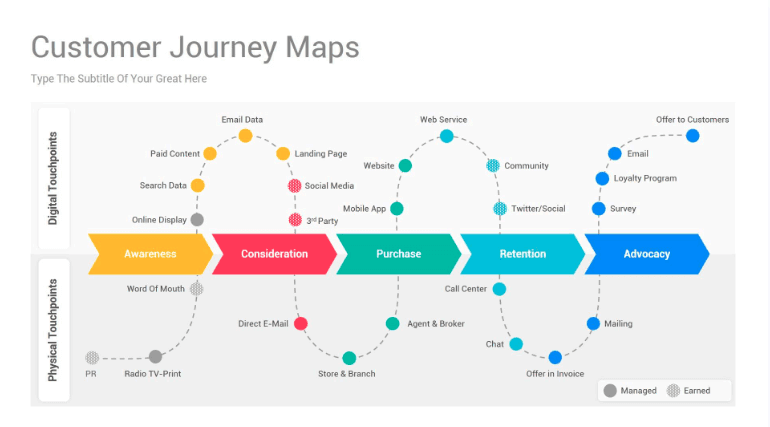
Imagine a user named Emily looking to buy a smartphone online.
Her user journey map might include stages like 'Research,' 'Compare Options,' 'Add to Cart,' 'Checkout,' and 'Post-Purchase.'
Each stage would detail her actions, emotions, and pain points.
For example, during the 'Checkout' stage, she might feel frustrated if the payment process is complicated. This map helps e-commerce businesses identify and address potential barriers to a successful purchase.
Healthcare Patient Experience
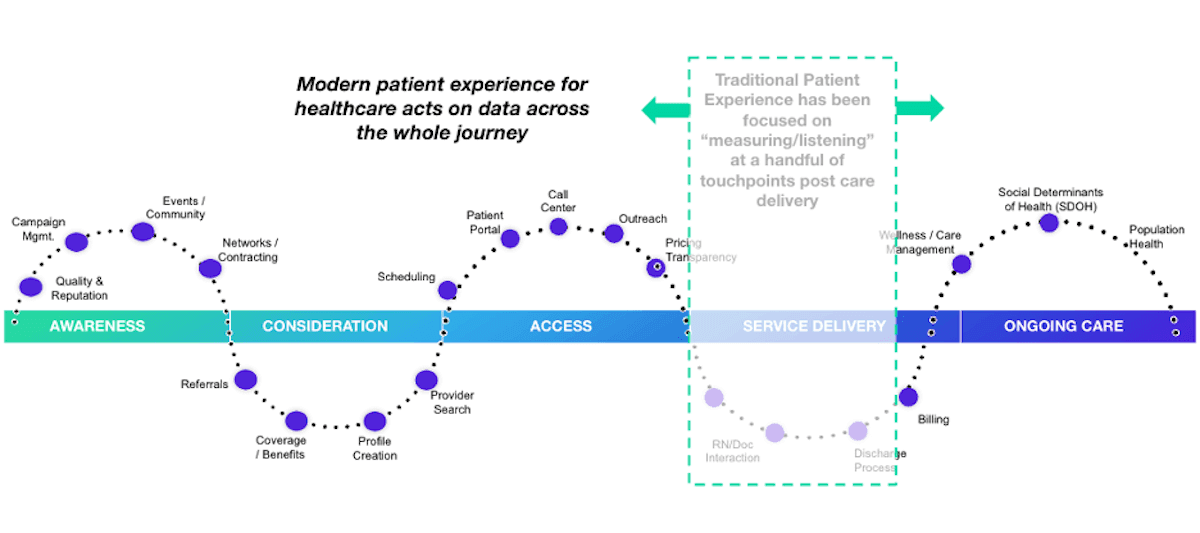
In the context of healthcare, a patient journey map could follow a patient named Alex from 'Appointment Booking' to 'Diagnosis' and 'Treatment Plan.'
Along the way, the map could highlight moments of anxiety, satisfaction, and confusion.
For example, during the 'Diagnosis' stage, Alex might appreciate clear explanations from the doctor, easing his concerns. This map aids healthcare providers in delivering empathetic care and streamlining administrative processes.
Travel Booking Process
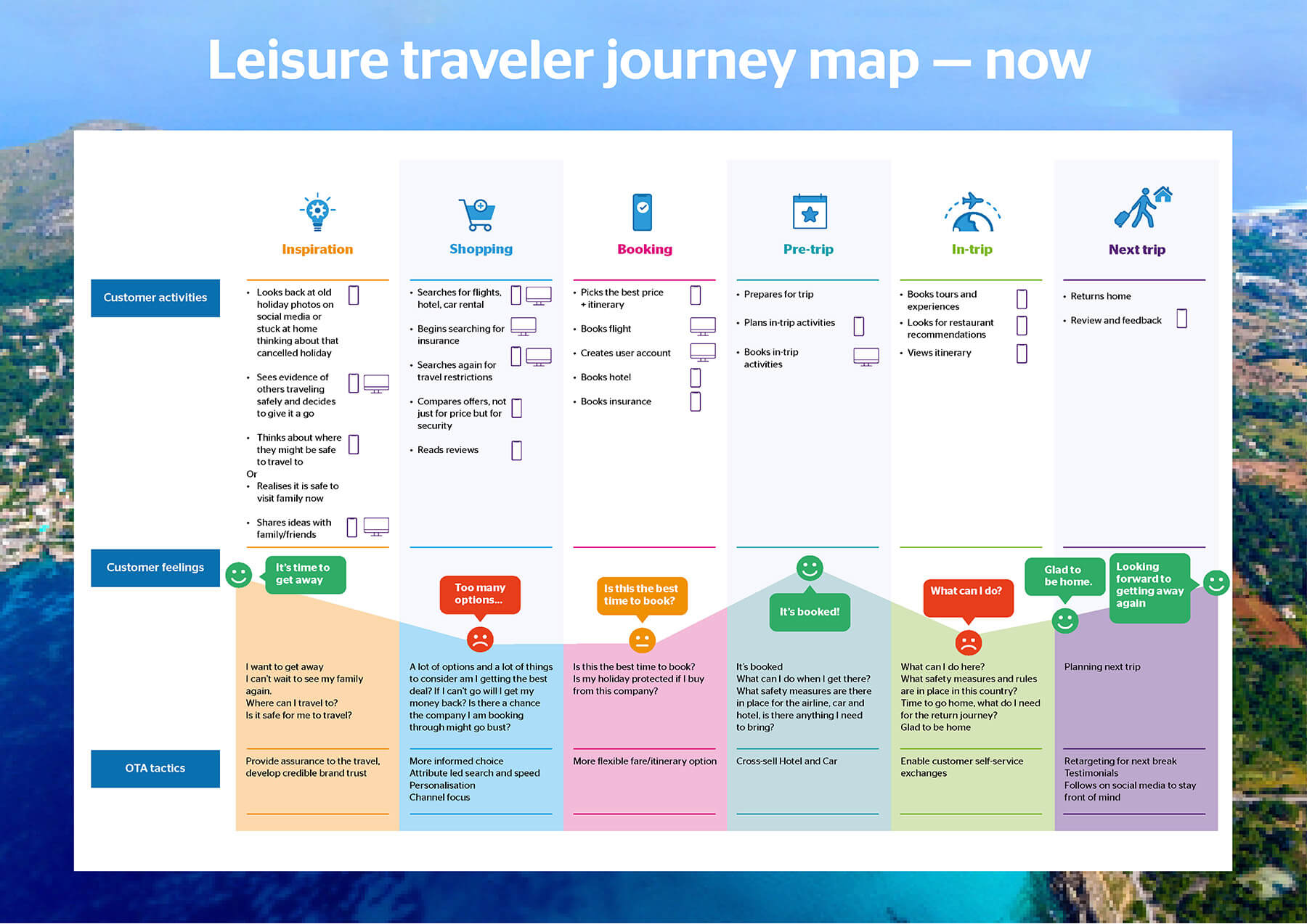
For a travel company, a user journey map could cover a traveler's experience from 'Destination Research' to 'Booking' and 'Post-Trip Feedback.'
As the traveler moves through these stages, the map could capture their interactions with the website, customer service, and the actual travel experience.
If the traveler faces difficulties during 'Booking,' like a confusing interface, the map helps the travel company identify areas for improvement.
Mobile App Onboarding
When designing a mobile app, a user journey map could depict the path a new user takes from 'Downloading the App' to 'First Use' and 'Regular Engagement.'
This map would showcase the user's interactions, emotions, and any challenges encountered during the onboarding process.
If a user struggles to understand the app's features during 'First Use,' the map guides developers in simplifying the introduction to the app.
Restaurant Dining Experience
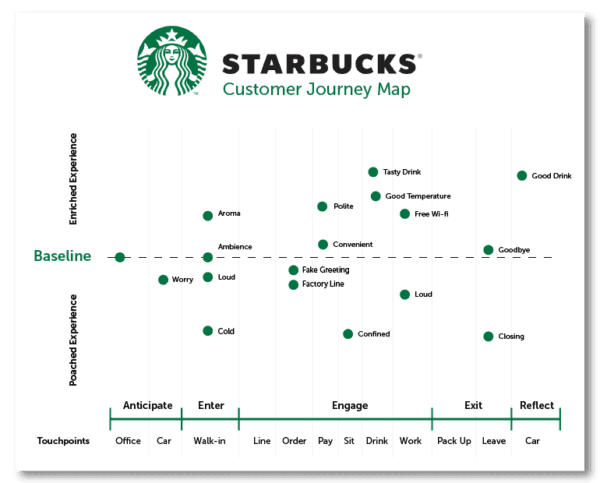
In the hospitality industry, a user journey map could follow a diner named Chris through the 'Reservation,' 'Arrival,' 'Dining,' and 'Payment' stages.
This map would capture Chris's emotional highs and lows during their visit.
For instance, a positive interaction with the waiter during the 'Dining' stage could enhance Chris's overall satisfaction. This map helps restaurants create memorable and pleasant dining experiences.
The examples above show how user journey maps can be useful for a variety of businesses. By understanding the experience users have with their products, services, and interactions organizations are able to make more informed decisions about what they offer.
Pitfalls to Avoid
While user journey mapping can help you plan and execute effective experiences, there are some traps to watch out for—here's what they are:
Making Assumptions
One of the most significant pitfalls is relying on assumptions rather than concrete data. Guessing how users feel or behave at different stages of the journey can lead to inaccurate maps. Instead, gather real user data through surveys, interviews, analytics, and observations to create an accurate representation of the journey.
Overgeneralization
Every user is unique, and their experiences might differ. Avoid overgeneralizing by considering various user segments, personas, and their specific needs. Design your maps to accommodate different user behaviors and preferences, creating a more inclusive and accurate picture.
Neglecting Negative Feedback
Negative feedback and pain points are valuable sources of information. Neglecting or downplaying negative experiences in your map can lead to missed opportunities for improvement. Embrace criticism and use it to identify areas that need enhancement.
Lack of Collaboration
Creating a user journey map involves multiple perspectives from different teams. Not involving representatives from customer service, marketing, design, and other relevant departments can result in an incomplete or biased map. Collaborate across teams to ensure a comprehensive and well-rounded perspective.
Static Maps
User behaviors and preferences evolve over time, so a static map can become outdated quickly. Avoid the pitfall of treating the map as a one-time task. Regularly update and refine the map to reflect changing user needs and market trends.
Ignoring Emotions
User journey maps aren't just about actions; they also capture user emotions. Failing to account for how users feel at each stage can lead to an incomplete understanding of the journey. Incorporate emotional insights to create a holistic view.
Skipping Validation
Before implementing changes based on the map, validate your assumptions. Test new strategies, features, or improvements with real users to ensure they have the desired impact. Skipping validation can lead to wasted resources and missed opportunities.
Disregarding Mobile and Multichannel Experiences
In today's world, users engage with businesses through various channels, including mobile apps and social media. Neglecting these touchpoints in your map can result in an incomplete understanding of the user journey. Account for all relevant channels to create a comprehensive map.
Focusing Solely on Digital Interactions
While digital interactions are crucial, the user journey often involves offline experiences as well. If your business has physical locations or offers in-person services, don't ignore these aspects in your map.
Losing Sight of Goals
Lastly, don't lose sight of your original goals. It's easy to get caught up in creating a detailed map and lose focus on the insights you aimed to gain. Keep your objectives in mind and ensure that your map serves the purpose of enhancing the user experience.
Tools for Customer Journey Map
These tools assist businesses in creating comprehensive customer journey maps, allowing visualization, tracking, and strategic alignment with customer experiences.
Digital First AI
Provides personalized business tactics recommendations.
Helps define the customer journey with tactical flow.
Access to a library of free tactics and funnel builder.
Miro
Cloud-based diagramming application.
Visualizes processes and systems.
ClickUp
Project management tool with a customer journey mapping feature.
Creates visual representations and tracks progress.
Smaply
Dedicated customer journey mapping tool.
Creates maps, personas, and stakeholder maps.
Offers templates and tools for visualization.
FlowMapp
Offers tools for user experience deliverables, including customer journey maps.
Pre-built blocks for every section of the map.
Integrates personas created on the platform.
Templates for Customer Journey
You can find templates to use as a starting point for creating your own customer journey map. Some templates are designed specifically for mapping the customer journey, while others are more general and can be used to create other types of maps as well.
You can find the templates below.
User Interviews: User Interviews offers a huge list of 150+ easy-to-use customer journey mapping templates and examples for user researchers, UX designers, PMs, and CX teams. The templates are organized by use case, software, experience, and design skill level.
Canva: Canva offers free and customizable customer journey map templates that can be easily shared and customized. The templates are professionally designed and can be edited to fit your specific needs.
WordStream: WordStream offers seven free customer journey map templates and examples that can be used to create a customer journey map. The templates are designed to be easy to use and come with placeholder text to help you get started.
Miro: Miro offers a customer journey map template that can be used to map your customer experience and understand their pain points. The template includes touchpoints and moments of truth, as well as potential customer feelings, such as frustration or confusion.
HubSpot: HubSpot offers free customer journey map templates that can help you map out your buyer's journey, a day in the life of your customer, lead nurturing, and more. The templates can help your sales, marketing, and customer support teams learn more about your company's buyer persona.
Build Marketing Workflows That Work for you

No credit card needed. Instant access. Try now for free
Digital First AI empowers marketers with AI-driven tools to centralize data, build personalized strategies, and execute campaigns seamlessly.
Generate content, automate workflows, and outpace competitors—all in one secure platform.
AI-Powered Data Room: Centralize and analyze unstructured data for actionable insights.
AI Strategy Canvases: Generate 26+ strategic canvases for tailored campaigns.
Advanced Research Tools: Conduct real-time market and competitor research.
AI Content & Visuals: Create high-quality copy and visuals with leading AI models.
Drag-and-Drop Workflow Builder: Design and automate custom workflows effortlessly.
Pre-Built Templates: Jumpstart campaigns with customizable templates.
Over 15,000 marketers and entrepreneurs from around the world are already reaping the benefits. Enjoy a free trial without any commitments!
It’s a Wrap
So, you've learned that figuring out what your customers think is super important.
It's like a secret recipe for making them happy and turning them into loyal fans who love buying from you.
We really hope this article was useful for you.
It should make creating your customer journey map a lot easier, so you don't forget any important steps along the way.



